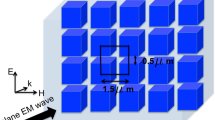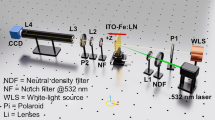Abstract
The light interactions between subwavelength apertures in metallic screens represent a basic diffraction phenomenon that has been studied for a long time. Initial reports have promoted the surface plasmon polariton (SPP) as the main vector responsible for the interaction. However, recent experimental results largely question this point of view and favour an interaction based on a new type of surface wave. Here we provide a comprehensive study of the different mechanisms involved in the electromagnetic interaction between optical nano-objects such as slits and holes at metallo-dielectric interfaces. We show that the interaction is driven by two very different near-field contributions, the SPP mode of the interface and a creeping wave. Although their relative impact strongly depends on the frequency range of interest and on the actual geometry of the nano-objects, SPPs are shown to be the primary vector of the interaction at visible frequencies.
This is a preview of subscription content, access via your institution
Access options
Subscribe to this journal
Receive 12 print issues and online access
$209.00 per year
only $17.42 per issue
Buy this article
- Purchase on Springer Link
- Instant access to full article PDF
Prices may be subject to local taxes which are calculated during checkout





Similar content being viewed by others
References
Barnes, W. L., Dereux, A. & Ebbesen, T. W. Surface plasmon subwavelength optics. Nature 424, 824–830 (2003).
Maier, S. A. & Atwater, H. A. Plasmonic, localization and guiding of electromagnetic energy in metal/dielectric structures. J. Appl. Phys. 98, 011101 (2005).
Ebbesen, T. W., Lezec, H. J., Ghaemi, H. F., Thio, T. & Wolff, P. A. Extraordinary optical transmission through sub-wavelength hole arrays. Nature 391, 667–669 (1998).
Lezec, H. J. et al. Beaming light from a subwavelength aperture. Science 297, 820–822 (2002).
García-Vidal, F. J., Lezec, H. J., Ebbesen, T. W. & Martin-Moreno, L. Multiple paths to enhance optical transmission through a single subwavelength slit. Phys. Rev. Lett. 90, 213901 (2003).
Lockyear, M. J., Hibbins, A. P., Sambles, J. R. & Lawrence, C. R. Enhanced microwave transmission through a single subwavelength aperture surrounded by concentric grooves. J. Opt. A 7, S152–S158 (2005).
Yin, L. et al. Surface plasmons at single nanoholes in Au films. Appl. Phys. Lett. 85, 467–469 (2004).
Schouten, H. F. et al. Plasmon-assisted two-slit transmission: Young’s experiment revisited. Phys. Rev. Lett. 94, 053901 (2005).
Lalanne, P., Hugonin, J. P. & Rodier, J. C. Theory of surface plasmon generation at nanoslit aperture. Phys. Rev. Lett. 95, 263902 (2005).
Gay, G. et al. Optical response of nanostructured surfaces: experimental investigation of the composite diffracted evanescent wave model. Nature Phys. 2, 262–267 (2006).
Silberstein, E., Lalanne, P., Hugonin, J. P. & Cao, Q. On the use of grating theory in integrated optics. J. Opt. Soc. Am. A. 18, 2865–2875 (2001).
Wilson, P.W. Determining optical properties of thin films by modified attenuated total reflection with a charge coupled device. J. Vac. Sci. Technol. A 6, 2386–2389 (1988).
Bennett, J. M., Stanford, J. L. & Ashley, E. J. Optical constants of silver sulfide tarnish films. J. Opt. Soc. Am. 60, 224–232 (1970).
Kowarz, M. W. Homogeneous and evanescent contribution in scalar near-field diffraction. Appl. Opt. 34, 3055–3063 (1995).
Palik, E. D. Handbook of Optical Constants of Solids Part II(1) (Academic, New York, 1985).
Acknowledgements
Financial support from the French contract ACN nanosciences 2004 and from the Network of Excellence on Micro-optics (NEMO) are acknowledged. The authors are grateful to J. Weiner for fruitful discussions and for providing us with experimental data, to J.-C. Rodier for providing computational assistance, and to P. Chavel for critical comments.
Author information
Authors and Affiliations
Corresponding author
Ethics declarations
Competing interests
The authors declare no competing financial interests.
Supplementary information
Rights and permissions
About this article
Cite this article
Lalanne, P., Hugonin, J. Interaction between optical nano-objects at metallo-dielectric interfaces. Nature Phys 2, 551–556 (2006). https://doi.org/10.1038/nphys364
Received:
Accepted:
Published:
Issue Date:
DOI: https://doi.org/10.1038/nphys364
This article is cited by
-
Application of Sub-wavelength Grating Electrodes in Photo Conductive Antennas
Plasmonics (2019)
-
Optical Properties of Periodic Metallic Slits with Asymmetric Binary Grooves
Plasmonics (2019)
-
Nanofilmed Fourier-Transformed Spectrometer with the Interference of Surface Plasmon Wave
Plasmonics (2018)
-
Nanoscale 2.5-dimensional surface patterning with plasmonic lithography
Scientific Reports (2017)
-
Characterization of three-dimensional field distribution of bowtie aperture using quasi-spherical waves and surface plasmon polaritons
Scientific Reports (2017)



